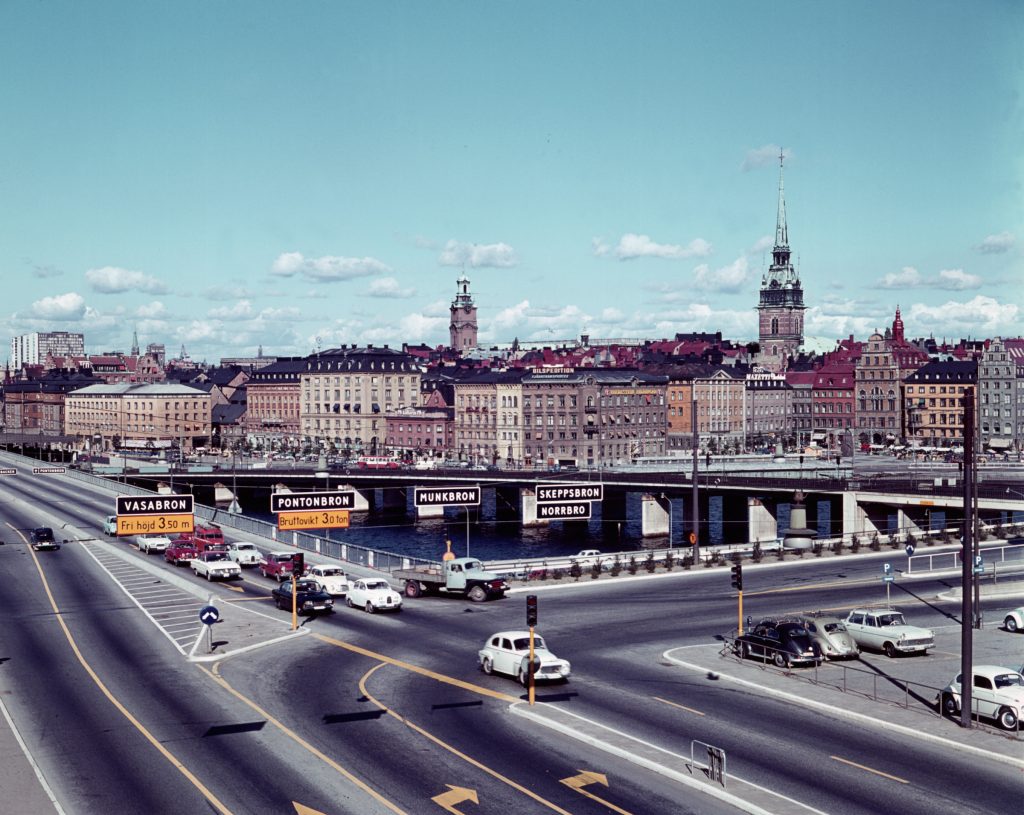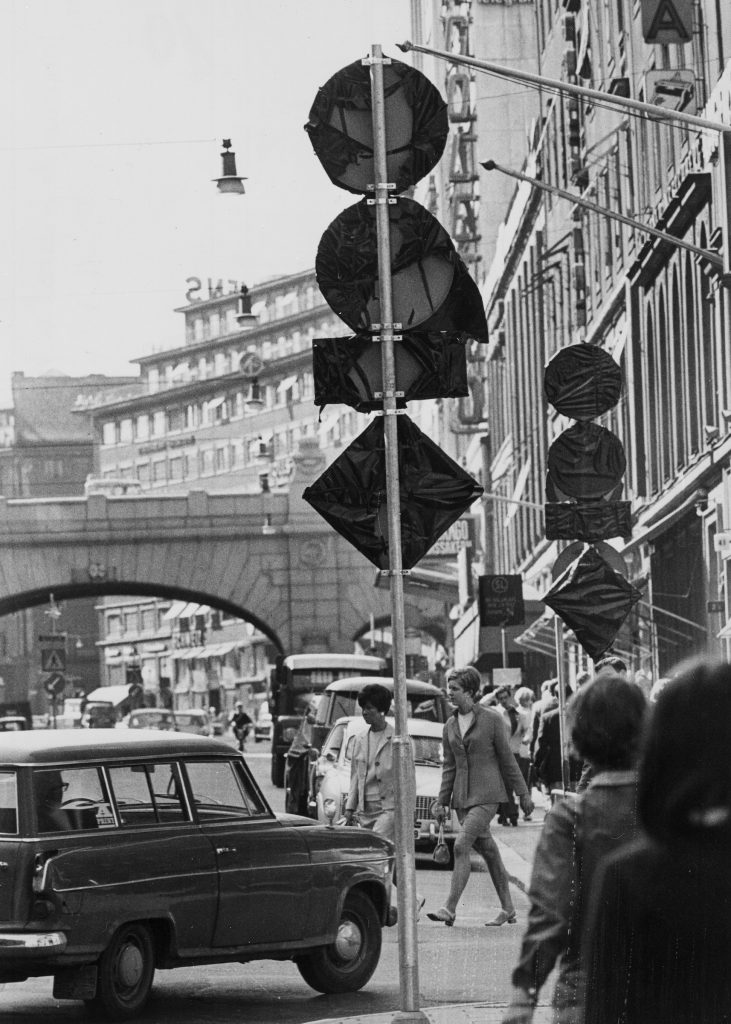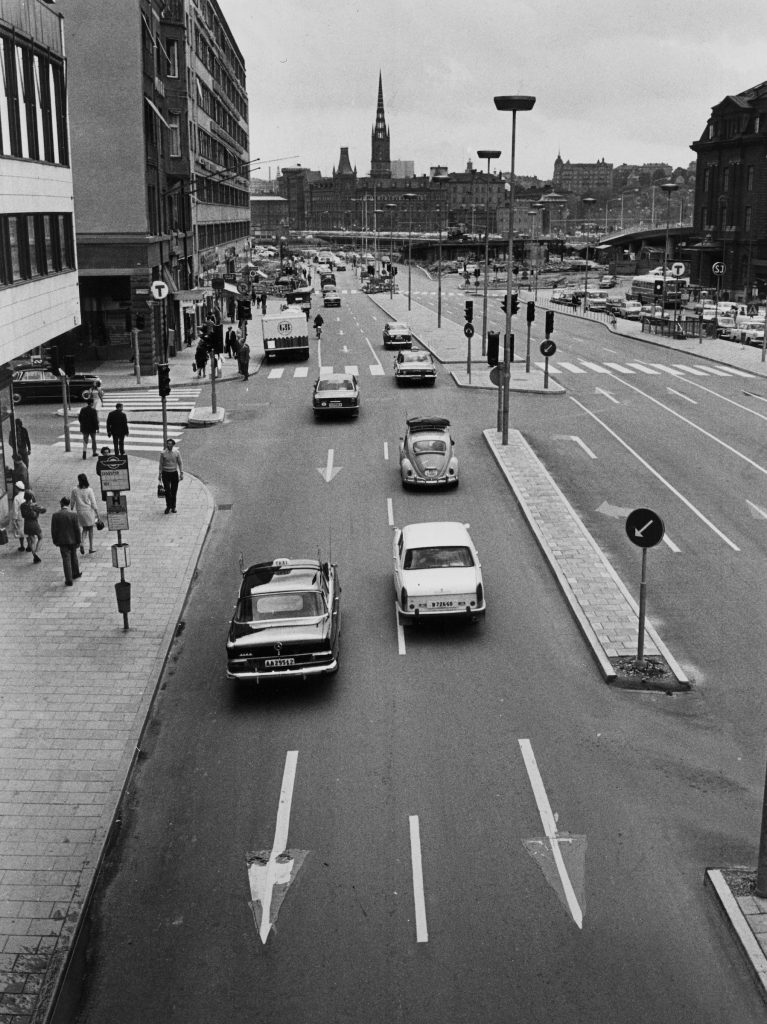In the early hours of September 3, 1967, all traffic across Sweden came to a halt. All non-essential cars were banned from the road from 1:00 a.m. onwards. At 4:50 a.m., everything on wheels stopped.
Then, in systematically careful fashion, every car, truck, and bus moved from the left to the right hand side of the road. Slowly, traffic began moving again, the streets flowing in a mirror image of the way they had the day before.

The Swedes called it Dagen H (literally “H Day”). It was one of the greatest traffic logistics solutions ever enacted. The problem it was designed to deal with was straightforward but quite serious. Up until this point, Swedes drove on the left side of the road (and on the right-hand side of the car), as is still the convention in the UK, Australia, and Japan. But in the countries that Sweden shares a land border with – namely, Finland and Norway – cars drive on the right side of the road. Crossing the border from Sweden into Norway was a bit of a kerfuffle, to say nothing of a visiting Finn in Stockholm getting a bit absentminded and driving the wrong way down a street.
Perhaps more pressing was that the Swedish themselves were wrecking cars by the hundreds. Traffic speeds had increased significantly through the 1950s and into the 1960s, and fatalities were way up. The vast majority of the cars driven in Sweden were left-hand-drive, which made passing on the right especially hazardous.
Hang on, I hear you saying, why didn’t the likes of Volvo and Saab simply build right-hand-drive cars? Surely, a country’s domestic auto manufacturers should build cars in accordance with its own rules of the road, no? Unfortunately, the reality of the situation was not so simple.
Horse sense

To understand the phenomena at work here, we need to delve into why different countries drive on different sides of the road.
As you might expect, the story begins when horsepower came from hairy beasts with two ears and four legs. Roadgoing conventions were first established in the era of horse-drawn transportation. Historians can’t entirely pinpoint when the practice of dividing up the roadway began, but it probably dates back to the invention of the sword. And in the past, different from the prevailing practice today, almost everyone stayed to the left.
Picture a mounted Roman cavalry officer riding down a track and encountering another rider headed the opposite direction. His right hand instinctively falls to the hilt of his sword, ready for action should this cloaked stranger present a threat. If he draws that sword, what’s the easiest side to defend on? The right, of course. So the two riders each keep to the left, and on they ride.
There are other considerations, familiar to any motorcyclist. Most people are right-handed, and similarly most people also are left-leg dominant. When throwing your leg over a motorcycle, the rider almost always approaches from the left. Some bikes even have ignition locks that engage with the handlebars turned to the left, and kickstands almost always lean to the left. In horseback days, staying to the left meant getting on and off on the verge, rather than in the middle of the road.
There is evidence to show that Roman charioteers and infantry columns followed the same practice of sticking to the left, and there was even a papal decree in the 1300s that pilgrims to Rome should keep to the left. But last time I checked, everything from the Fiat 500 to the Ferrari F40 has the wheel on the right. So, what gives?
“Right” of way for wagons

The reason most of Europe and North America drives on the right is thanks to Napoleon and the Teamsters (regrettably, not a band name). In post-medieval times, wagon trains became the chief way to transport goods on land, and that whole business about swords was less of an issue. An early wagon driver with several oxen or horses lashed together in pairs would sit on the left-rear animal in the team, such that his right hand – holding the whip – was capable of keeping every member of the team going.
With two heavily-laden wagons passing one another, it was easier for the two drivers to keep right because they could more easily ensure that the sides of their wagons didn’t collide. Napoleon, who was actually left-handed, codified this into law in 1792 and later applied that law to French colonies.
“Left” out
The British, meanwhile, made keeping to the left the law. Wagon trains were less important to trade in an island nation like England, particularly one with a developed system of canals. As British and French clashed over ownership of global resources, passing on the right or left became a point of contention that played out in the respective imperial colonies.
This, as you have probably gathered, is why Australians and New Zealanders today drive on the left.
Yes, one fractious former British colony did throw off all possible vestiges of the empire’s oppressive yoke. It’s the US of A, of course! (Actually, it’s possible driving on the right wasn’t a political choice at all in the US, as much as a consequence of the wagon-pulling phenomenon. But I digress.)
Meanwhile, in Canada, both approaches were going on simultaneously. In what must have surely been a thoroughly confusing time, anyone driving from the west coast to the east coast of Canada in 1919 would have started out driving on the left in British Columbia, switched to the right in Ontario, then back to the left by the time they hit the maritimes provinces. Newfoundlanders drove on the left until 1949.
And so we come back to Sweden

In Europe, most countries switched to driving on the right side of the road long before the first cars arrived. Sweden was a holdout, but no-one can seem to agree on exactly why. Keeping to the left became law in 1916, and many Swedish-built buses up until the 1960s were right-hand-drive, with doors opening on the left.
Here’s where it got dicey for the Swedes. Well-known domestic car companies like Saab and Volvo didn’t really get production going to scale until the 1950s, so until then, the passenger car market in Sweden was served by the likes of Ford, General Motors, and Chrysler. And, as we know, American automakers built cars to drive on the right side of the road. (This bit of history also helps explain the voracious – and enduring – Swedish appetite for Detroit iron. It’s an ongoing mania, with some 8000 muscle cars, cruisers, and hot rods gather in Lidkōping for a celebration earlier this year.)
Your average Swedish driver – let’s call him Lars Svensson – most likely owned a left-hand-drive Chevrolet (the top-selling marque until 1948). When Lars was stuck behind a Volvo truck on a winding country road in 1950, he couldn’t really see when it was safe to pass.
Happily, the Swedish government aimed to fix this conundrum. In 1955, a public referendum was held to discuss changing driving from the left side of the road to the right. Eighty-three percent of the public said, “No thanks we’re fine just crashing.”
Their problem with the initiative was, ostensibly, its cost: many millions of Swedish Krona in signage, roadworks, and labour. Also at work was the natural societal resistance to change. The devil you know, and all.
Dagen H and its lasting legacy

Against public opinion, Dagen H went ahead anyway. The H stands for “Högertrafikomlāggningen” which means “right-hand traffic reorganisation,” and also proves that the Germans don’t have a monopoly on long compound words.
The move was a shrewd one, in the end. Crashes dropped significantly, and Volvo and Saab ended up looking smart for not wasting money building right-hand-drive cars.
There were other, much weirder after-effects. Sweden’s government agencies organised a song contest as part of the efforts to remind the public not to drive on the left. The winning entry, “Keep to the right, Svensson,” ended up placing high in the country’s pop music charts.
We could leave things there. Instead, we invite you to come travel with us some 9200 miles from Stockholm, all the way to a small chain of islands in the Pacific. In tropical Samoa, people drive on the left-hand side of the road, a change they made in 2007. Why? Because of proximity of Australia and New Zealand. With most cars in Samoa being right-hand-drive imports from those countries, it’s the inverse situation of Sweden’s 1960s change on Dagen H. Samoa’s swap wasn’t easy to do, and there was similar public disapproval about the initiative. But as it turned out, most people think it was the right thing to do. Or rather the left thing.
This article was originally published on Hagerty US.
Read more
Ad Break: Test drive the rest, you’ll still buy a Saab 99
Sixty years of Volvo’s seatbelt patent
Buying Guide: Saab 900 Turbo (1979 – 1993)










And in Japan?